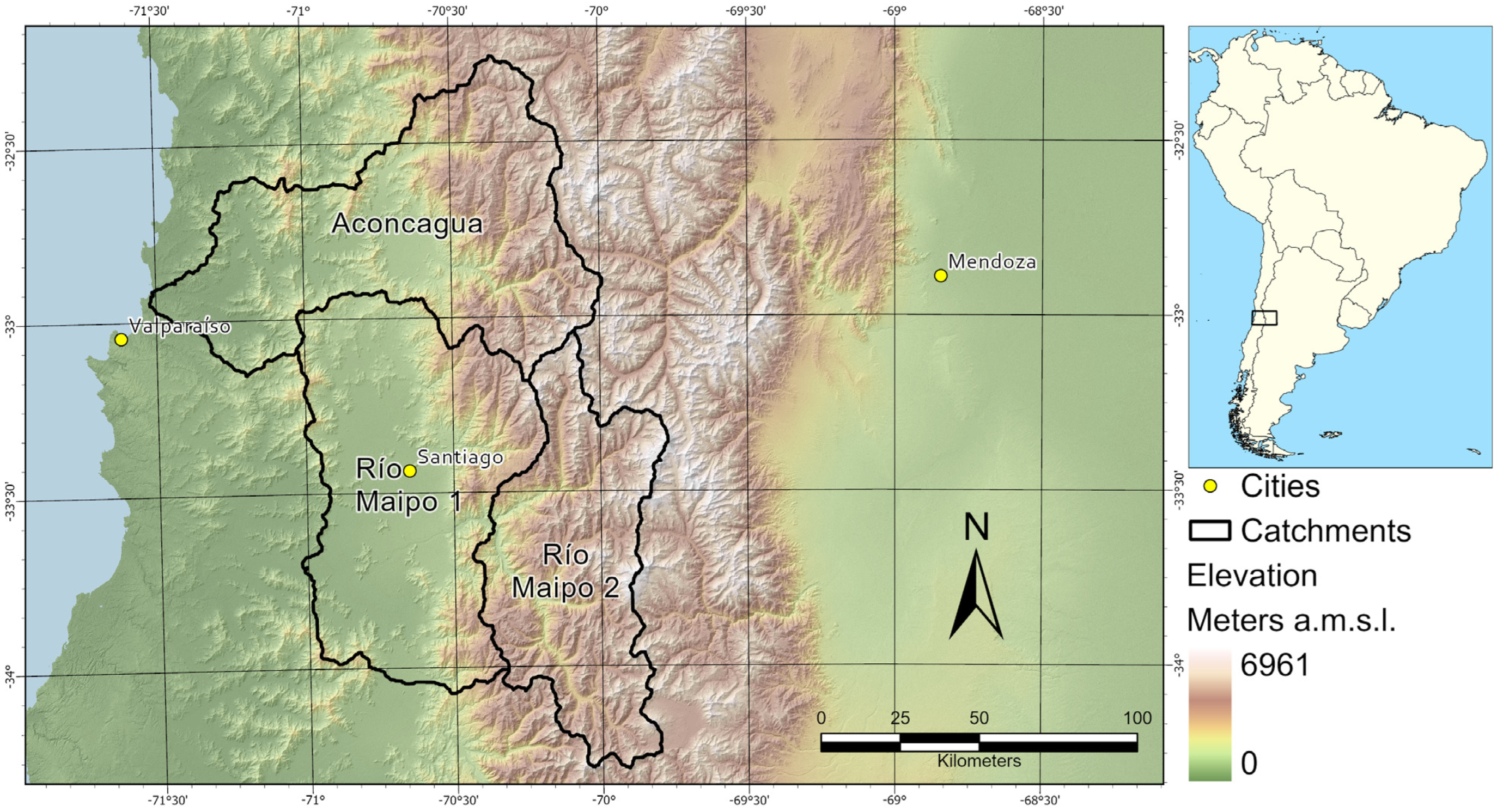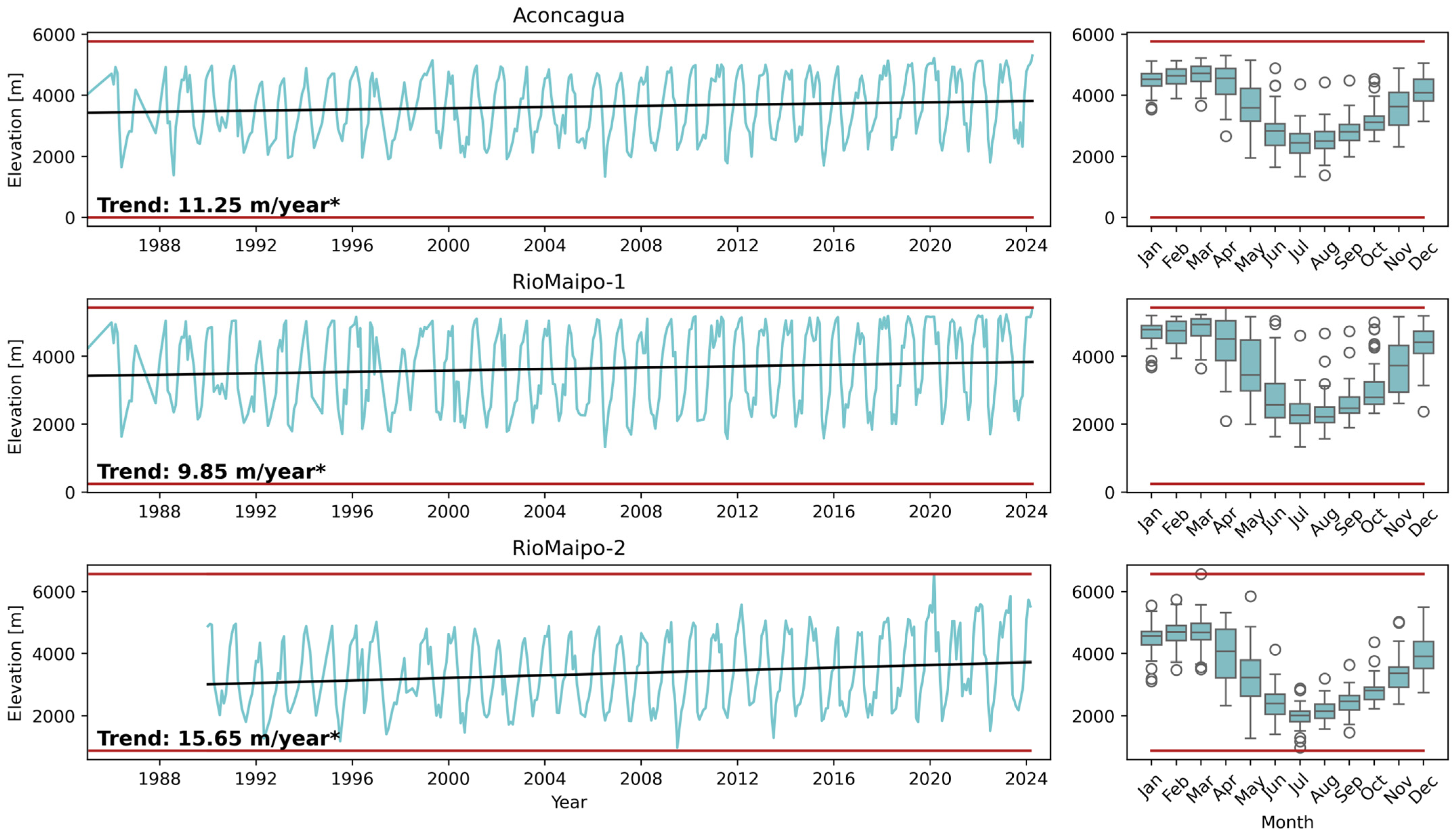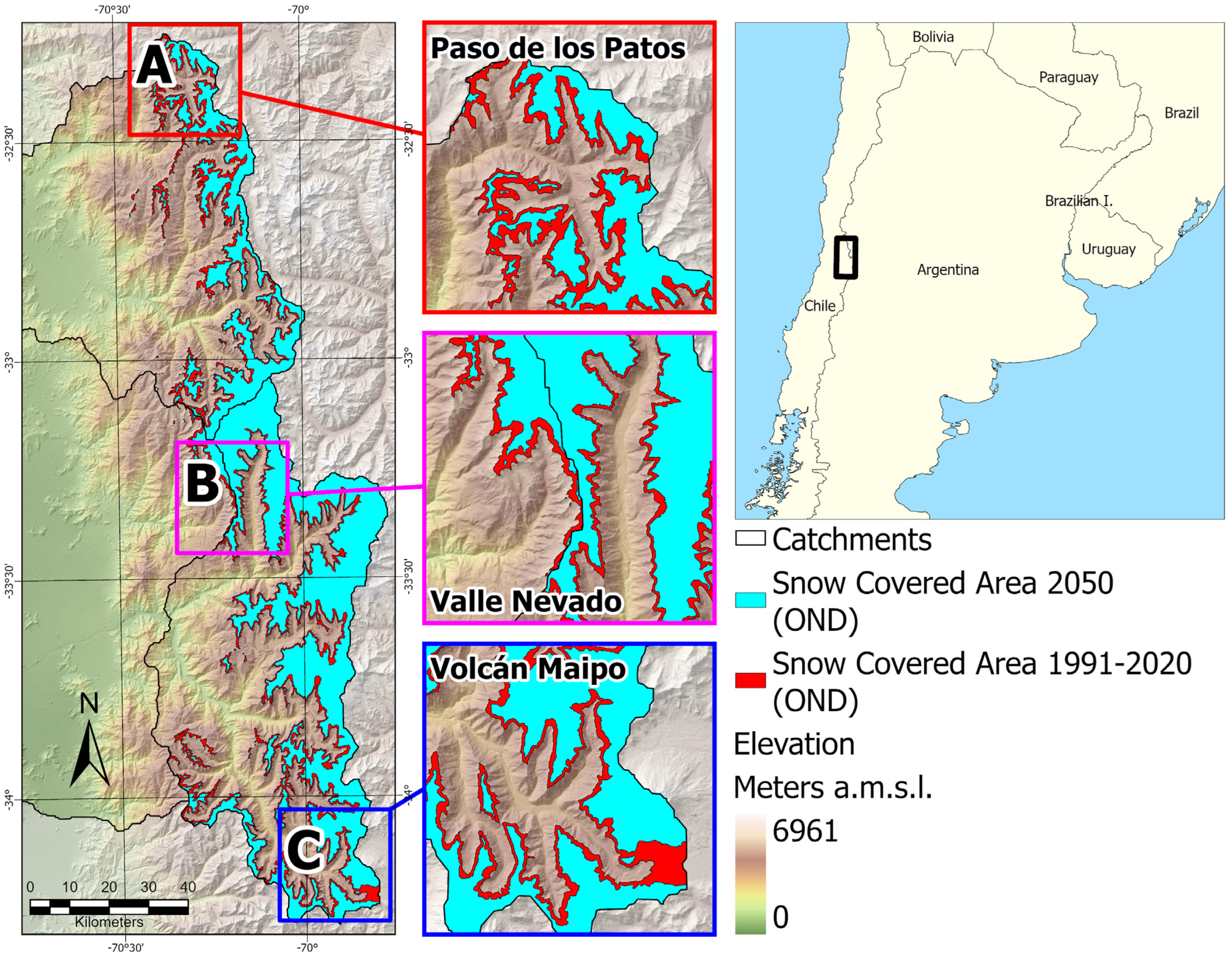Snow Cover Trends in the Chilean Andes Derived from 39 Years of Landsat Data and a Projection for the Year 2050
Abstract
1. Introduction
- Derive multi-decadal time series of SLE dynamics from Landsat data, starting from 1985;
- Calculate SLE trends for the major catchments of central Chile, including SLE anomalies on a monthly and seasonal basis; SLE trends on a seasonal basis, especially for the dry season (January through March; JFM) and for October and November, where runoff from snowmelt is greatest and runoff from glacier melt at its minimum;
- Project the evolution of the SLE based on the derived trends for the potential SLE situation in the year 2050 and determine whether remote sensing-based data and methods can be used to predict small-scale developments and changes of the cryosphere in the Andes Mountains.
2. Study Area
2.1. Aconcagua Catchment
2.2. Río Maipo Catchment
2.3. Climate
3. Materials and Methods
3.1. Data
3.2. Snow Classification
3.3. Snow Line Elevation Retrieval and Time Series Generation
4. Results
4.1. Properties of the SLE Time Series and Long-Term Dynamics
4.2. Seasonal SLE Trends and Extrapolation
5. Discussion
5.1. Accuracy of the Derived SLEs and Aspects Influencing This Accuracy
5.2. SLE Trends and Anomalies for Río Maipo and Aconcagua Catchments in the Chilean Central Andes
5.3. Future SLE Dynamics in the Andes and the Impact on Water Availability
6. Conclusions
Supplementary Materials
Author Contributions
Funding
Data Availability Statement
Conflicts of Interest
References
- National Statistics Institute (INE) of Chile. Available online: https://www.ine.gob.cl/home (accessed on 11 April 2025).
- Cordero, R.R.; Feron, S.; Damiani, A.; MacDonell, S.; Carrasco, J.; Pizarro, J.; Karas, C.; Jorquera, J.; Sepulveda, E.; Cabello, F.; et al. Rapid Decline in Extratropical Andean Snow Cover Driven by the Poleward Migration of the Southern Hemisphere Westerlies. Sci. Rep. 2024, 14, 26365. [Google Scholar] [CrossRef] [PubMed]
- Masiokas, M.H.; Rabatel, A.; Rivera, A.; Ruiz, L.; Pitte, P.; Ceballos, J.L.; Barcaza, G.; Soruco, A.; Bown, F.; Berthier, E.; et al. A Review of the Current State and Recent Changes of the Andean Cryosphere. Front. Earth Sci. 2020, 8, 99. [Google Scholar] [CrossRef]
- Boisier, J.P.; Rondanelli, R.; Garreaud, R.D.; Muñoz, F. Anthropogenic and Natural Contributions to the Southeast Pacific Precipitation Decline and Recent Megadrought in Central Chile. Geophys. Res. Lett. 2016, 43, 413–421. [Google Scholar] [CrossRef]
- Barnett, T.P.; Adam, J.C.; Lettenmaier, D.P. Potential Impacts of a Warming Climate on Water Availability in Snow-Dominated Regions. Nature 2005, 438, 303–309. [Google Scholar] [CrossRef] [PubMed]
- Cortés, G.; Margulis, S. Impacts of El Niño and La Niña on Interannual Snow Accumulation in the Andes: Results from a High-resolution 31 Year Reanalysis. Geophys. Res. Lett. 2017, 44, 6859–6867. [Google Scholar] [CrossRef]
- Bormann, K.J.; McCabe, M.F.; Evans, J.P. Satellite Based Observations for Seasonal Snow Cover Detection and Characterisation in Australia. Remote Sens. Environ. 2012, 123, 57–71. [Google Scholar] [CrossRef]
- Gascoin, S.; Luojus, K.; Nagler, T.; Lievens, H.; Masiokas, M.; Jonas, T.; Zheng, Z.; De Rosnay, P. Remote Sensing of Mountain Snow from Space: Status and Recommendations. Front. Earth Sci. 2024, 12, 1381323. [Google Scholar] [CrossRef]
- WMO; GCOS. Systematic Observation Requirements for Satellite-Based Data Products for Climate—2011 Update; WMO; GCOS: Geneva, Switzerland, 2011. [Google Scholar]
- Koehler, J.; Bauer, A.; Dietz, A.J.; Kuenzer, C. Towards Forecasting Future Snow Cover Dynamics in the European Alps—The Potential of Long Optical Remote-Sensing Time Series. Remote Sens. 2022, 14, 4461. [Google Scholar] [CrossRef]
- Wang, J.; Tang, Z.; Deng, G.; Hu, G.; You, Y.; Zhao, Y. Landsat Satellites Observed Dynamics of Snowline Altitude at the End of the Melting Season, Himalayas, 1991–2022. Remote Sens. 2023, 15, 2534. [Google Scholar] [CrossRef]
- Cordero, R.R.; Asencio, V.; Feron, S.; Damiani, A.; Llanillo, P.J.; Sepulveda, E.; Jorquera, J.; Carrasco, J.; Casassa, G. Dry-Season Snow Cover Losses in the Andes (18°–40°S) Driven by Changes in Large-Scale Climate Modes. Sci. Rep. 2019, 9, 16945. [Google Scholar] [CrossRef]
- Saavedra, F.A.; Kampf, S.K.; Fassnacht, S.R.; Sibold, J.S. A Snow Climatology of the Andes Mountains from MODIS Snow Cover Data. Intl. J. Climatol. 2017, 37, 1526–1539. [Google Scholar] [CrossRef]
- Saavedra, F.A.; Kampf, S.K.; Fassnacht, S.R.; Sibold, J.S. Changes in Andes Snow Cover from MODIS Data, 2000–2016. Cryosphere 2018, 12, 1027–1046. [Google Scholar] [CrossRef]
- Hanshaw, M.N.; Bookhagen, B. Glacial Areas, Lake Areas, and Snow Lines from 1975 to 2012: Status of the Cordillera Vilcanota, Including the Quelccaya Ice Cap, Northern Central Andes, Peru. Cryosphere 2014, 8, 359–376. [Google Scholar] [CrossRef]
- Arnaud, Y.; Muller, F.; Vuille, M.; Ribstein, P. El Niño-Southern Oscillation (ENSO) Influence on a Sajama Volcano Glacier (Bolivia) from 1963 to 1998 as Seen from Landsat Data and Aerial Photography. J. Geophys. Res. 2001, 106, 17773–17784. [Google Scholar] [CrossRef]
- Krajčí, P.; Holko, L.; Perdigão, R.A.P.; Parajka, J. Estimation of Regional Snowline Elevation (RSLE) from MODIS Images for Seasonally Snow Covered Mountain Basins. J. Hydrol. 2014, 519, 1769–1778. [Google Scholar] [CrossRef]
- Hu, Z.; Dietz, A.J.; Kuenzer, C. Deriving Regional Snow Line Dynamics during the Ablation Seasons 1984–2018 in European Mountains. Remote Sens. 2019, 11, 933. [Google Scholar] [CrossRef]
- Vuille, M.; Ammann, C. Regional Snowfall Patterns in the High, Arid Andes. Clim. Change 1997, 36, 413–423. [Google Scholar] [CrossRef]
- Ayala, A.; McPhee, J.; Vargas, X. Altitudinal Gradients, Midwinter Melt, and Wind Effects on Snow Accumulation in Semiarid Midlatitude Andes under La Niña Conditions. Water Resour. Res. 2014, 50, 3589–3594. [Google Scholar] [CrossRef]
- Apaloo, J.; Brenning, A.; Bodin, X. Interactions between Seasonal Snow Cover, Ground Surface Temperature and Topography (Andes of Santiago, Chile, 33.5°S). Permafr. Periglac. 2012, 23, 277–291. [Google Scholar] [CrossRef]
- Carrasco, J.F.; Casassa, G.; Quintana, J. Changes of the 0 °C Isotherm and the Equilibrium Line Altitude in Central Chile during the Last Quarter of the 20th Century/Changements de l’isotherme 0 °C et de La Ligne d’équilibre Des Neiges Dans Le Chili Central Durant Le Dernier Quart Du 20ème Siècle. Hydrol. Sci. J. 2005, 50, 11. [Google Scholar] [CrossRef]
- Lehner, B.; Grill, G. Global River Hydrography and Network Routing: Baseline Data and New Approaches to Study the World’s Large River Systems. Hydrol. Process. 2013, 27, 2171–2186. [Google Scholar] [CrossRef]
- Ohlanders, N.; Rodriguez, M.; McPhee, J. Stable Water Isotope Variation in a Central Andean Watershed Dominated by Glacier and Snowmelt. Hydrol. Earth Syst. Sci. 2013, 17, 1035–1050. [Google Scholar] [CrossRef]
- Sangüesa, C.; Pizarro, R.; Ingram, B.; Balocchi, F.; García-Chevesich, P.; Pino, J.; Ibáñez, A.; Vallejos, C.; Mendoza, R.; Bernal, A.; et al. Streamflow Trends in Central Chile. Hydrology 2023, 10, 144. [Google Scholar] [CrossRef]
- Pellicciotti, F.; Burlando, P.; van Vliet, K. Recent Trends in Precipitation and Streamflow in the Aconcagua River Basin, Central Chile. In Glacier Mass Balance Changes and Meltwater Discharge; IAHS Publication: Wallingford, UK, 2007; Volume 318, pp. 17–38. [Google Scholar]
- Rutllant, J.; Fuenzalida, H. Synoptic Aspects of the Central Chile Rainfall Variability Associated with the Southern Oscillation. Int. J. Climatol. 1991, 11, 63–76. [Google Scholar] [CrossRef]
- Corripio, J.G.; Purves, R.S.; Rivera, A. Modeling Climate-Change Impacts on Mountain Glaciers and Water Resources in the Central Dry Andes. 2008. Available online: https://www.google.ca/url?sa=t&source=web&rct=j&opi=89978449&url=https://glaciologia.cl/wp-content/uploads/2020/08/71.Corripio_Purves_2008.pdf&ved=2ahUKEwjU_qmgs_yMAxVg4zQHHZN6CfMQFnoECBkQAQ&usg=AOvVaw2RqKzoOE6dybMYv2tqRqkf (accessed on 20 February 2025).
- Falvey, M.; Garreaud, R.D. Regional Cooling in a Warming World: Recent Temperature Trends in the Southeast Pacific and along the West Coast of Subtropical South America (1979–2006). J. Geophys. Res. 2009, 114, 2008JD010519. [Google Scholar] [CrossRef]
- Carrasco, J.F.; Osorio, R.; Casassa, G. Secular Trend of the Equilibrium-Line Altitude on the Western Side of the Southern Andes, Derived from Radiosonde and Surface Observations. J. Glaciol. 2008, 54, 538–550. [Google Scholar] [CrossRef]
- Garreaud, R.D.; Alvarez-Garreton, C.; Barichivich, J.; Boisier, J.P.; Christie, D.; Galleguillos, M.; LeQuesne, C.; McPhee, J.; Zambrano-Bigiarini, M. The 2010–2015 Megadrought in Central Chile: Impacts on Regional Hydroclimate and Vegetation. Hydrol. Earth Syst. Sci. 2017, 21, 6307–6327. [Google Scholar] [CrossRef]
- Álamos, N.; Alvarez-Garreton, C.; Muñoz, A.; González-Reyes, Á. The Influence of Human Activities on Streamflow Reductions during the Megadrought in Central Chile. Hydrol. Earth Syst. Sci. 2024, 28, 2483–2503. [Google Scholar] [CrossRef]
- Earth Resources Observation and Science (EROS) Center. Collection-2 Landsat 4-5 Thematic Mapper (TM) Level-2 Science Products. Available online: https://www.usgs.gov/centers/eros/science/usgs-eros-archive-landsat-archives-landsat-4-5-tm-collection-2-level-2-science (accessed on 20 February 2025).
- Copernicus DEM—Global and European Digital Elevation Model (COP-DEM). Available online: https://dataspace.copernicus.eu/explore-data/data-collections/copernicus-contributing-missions/collections-description/COP-DEM (accessed on 10 January 2025).
- Ripper, E.; Schwaizer, G.; Nagler, T.; Metsämäki, S.; Törmä, M.; Fernandes, R.; Crawford, C.J.; Painter, T.; Rittger, K. Guidelines for the Generation of Snow Extent Products from High Resolution Optical Sensors—FINAL Deliverable D8. 2019, 58. Available online: https://snowpex.enveo.at/doc/D08_Guidelines_for_the_generation_of_snow_extent_products_from_HR_optical_sensors_FINAL_v2.1.pdf (accessed on 10 January 2025).
- Klein, A.G.; Hall, D.K.; Riggs, G.A. Improving Snow Cover Mapping in Forests through the Use of a Canopy Reflectance Model. Hydrol. Process. 1998, 12, 1723–1744. [Google Scholar] [CrossRef]
- Poon, S.K.M.; Valeo, C. Investigation of the MODIS Snow Mapping Algorithm during Snowmelt in the Northern Boreal Forest of Canada. Can. J. Remote Sens. 2006, 32, 254–267. [Google Scholar] [CrossRef]
- Metsämäki, S.; Pulliainen, J.; Salminen, M.; Luojus, K.; Wiesmann, A.; Solberg, R.; Böttcher, K.; Hiltunen, M.; Ripper, E. Introduction to GlobSnow Snow Extent Products with Considerations for Accuracy Assessment. Remote Sens. Environ. 2015, 156, 96–108. [Google Scholar] [CrossRef]
- Hall, D.K.; Riggs, G.A.; Foster, J.L.; Kumar, S.V. Development and Evaluation of a Cloud-Gap-Filled MODIS Daily Snow-Cover Product. Remote Sens. Environ. 2010, 114, 496–503. [Google Scholar] [CrossRef]
- Tucker, C.J. Red and Photographic Infrared Linear Combinations for Monitoring Vegetation. Remote Sens. Environ. 1979, 8, 127–150. [Google Scholar] [CrossRef]
- Gao, B. NDWI—A Normalized Difference Water Index for Remote Sensing of Vegetation Liquid Water from Space. Remote Sens. Environ. 1996, 58, 257–266. [Google Scholar] [CrossRef]
- Zhu, Z.; Wang, S.; Woodcock, C.E. Improvement and Expansion of the Fmask Algorithm: Cloud, Cloud Shadow, and Snow Detection for Landsats 4–7, 8, and Sentinel 2 Images. Remote Sens. Environ. 2015, 159, 269–277. [Google Scholar] [CrossRef]
- Main-Knorn, M.; Pflug, B.; Louis, J.; Debaecker, V.; Müller-Wilm, U.; Gascon, F. Sen2Cor for Sentinel-2. In Proceedings of the Image and Signal Processing for Remote Sensing XXIII, Warsaw, Poland, 11–13 September 2017; Bruzzone, L., Bovolo, F., Benediktsson, J.A., Eds.; SPIE: Warsaw, Poland, 2017; p. 3. [Google Scholar]
- Hirsch, R.M.; Slack, J.R.; Smith, R.A. Techniques of Trend Analysis for Monthly Water Quality Data. Water Resour. Res. 1982, 18, 107–121. [Google Scholar] [CrossRef]
- Sen, P.K. Estimates of the Regression Coefficient Based on Kendall’s Tau. J. Am. Stat. Assoc. 1968, 63, 1379–1389. [Google Scholar] [CrossRef]
- Bolaño-Ortiz, T.R.; Ruggeri, M.; Berná Peña, L.L.; Puliafito, S.E.; Cereceda-Balic, F. Snow Surface Albedo Changes in the Last Two Decades across the South America (11°N-76°S): Some Highlights Revealed by Satellite Observations. In Proceedings of the AGU Fall Meeting 2020, San Francisco, CA, USA, 1–17 December 2020. [Google Scholar]
- Thonfeld, F.; Gessner, U.; Holzwarth, S.; Kriese, J.; da Ponte, E.; Huth, J.; Kuenzer, C. A First Assessment of Canopy Cover Loss in Germany’s Forests after the 2018–2020 Drought Years. Remote Sens. 2022, 14, 562. [Google Scholar] [CrossRef]
- Wenzl, M.; Baumhoer, C.A.; Dietz, A.J.; Kuenzer, C. Vegetation Changes in the Arctic: A Review of Earth Observation Applications. Remote Sens. 2024, 16, 4509. [Google Scholar] [CrossRef]
- Strozzi, T.; Paul, F.; Wiesmann, A.; Schellenberger, T.; Kääb, A. Circum-Arctic Changes in the Flow of Glaciers and Ice Caps from Satellite SAR Data between the 1990s and 2017. Remote Sens. 2017, 9, 947. [Google Scholar] [CrossRef]
- Cornwell, E.; Molotch, N.P.; McPhee, J. Spatio-Temporal Variability of Snow Water Equivalent in the Extra-Tropical Andes Cordillera from Distributed Energy Balance Modeling and Remotely Sensed Snow Cover. Hydrol. Earth Syst. Sci. 2016, 20, 411–430. [Google Scholar] [CrossRef]
- Notarnicola, C. Overall Negative Trends for Snow Cover Extent and Duration in Global Mountain Regions over 1982–2020. Sci. Rep. 2022, 12, 13731. [Google Scholar] [CrossRef]
- Şen, Z. Moving Trend Analysis Methodology for Hydro-Meteorology Time Series Dynamic Assessment. Water Resour. Manag. 2024, 38, 4415–4429. [Google Scholar] [CrossRef]
- Bown, F.; Rivera, A.; Acuña, C. Recent Glacier Variations at the Aconcagua Basin, Central Chilean Andes. Ann. Glaciol. 2008, 48, 43–48. [Google Scholar] [CrossRef]
- Hu, L.Q.; Zhang, L.C.; Li, S.; Li, H.J.; Zhang, T.W.; Hou, X.G. Remote Sensing-Based Extraction of Summer Snowline and Analysis of Its Variation Characteristics in Xinjiang, China. Appl. Ecol. Env. Res. 2018, 16, 6281–6298. [Google Scholar] [CrossRef]
- Intergovernmental Panel on Climate Change (IPCC). The Ocean and Cryosphere in a Changing Climate: Special Report of the Intergovernmental Panel on Climate Change, 1st ed.; Cambridge University Press: Cambridge, UK, 2022; ISBN 978-1-00-915796-4. [Google Scholar]
- Boisier, J.P.; Alvarez-Garreton, C.; Cordero, R.R.; Damiani, A.; Gallardo, L.; Garreaud, R.D.; Lambert, F.; Ramallo, C.; Rojas, M.; Rondanelli, R. Anthropogenic Drying in Central-Southern Chile Evidenced by Long-Term Observations and Climate Model Simulations. Elem. Sci. Anthr. 2018, 6, 74. [Google Scholar] [CrossRef]
- Alvarez-Garreton, C.; Boisier, J.P.; Garreaud, R.; González, J.; Rondanelli, R.; Gayó, E.; Zambrano-Bigiarini, M. HESS Opinions: The Unsustainable Use of Groundwater Conceals a “Day Zero”. Hydrol. Earth Syst. Sci. 2024, 28, 1605–1616. [Google Scholar] [CrossRef]
- Vicuña, S.; Vargas, X.; Boisier, J.P.; Mendoza, P.A.; Gómez, T.; Vásquez, N.; Cepeda, J. Impacts of Climate Change on Water Resources in Chile. In Water Resources of Chile; Fernández, B., Gironás, J., Eds.; World Water Resources; Springer International Publishing: Cham, Switzerland, 2021; Volume 8, pp. 347–363. ISBN 978-3-030-56900-6. [Google Scholar]
- OECD. OECD Environmental Performance Reviews: Chile 2024. In OECD Environmental Performance Reviews; OECD: Paris, France, 2024; ISBN 978-92-64-73497-5. [Google Scholar]
- The GlaMBIE Team. Community Estimate of Global Glacier Mass Changes from 2000 to 2023. Nature 2025, 639, 382–388. [Google Scholar] [CrossRef]






| River Catchment | Total Area [km2] | Max. Elevation [m a.s.l.] | Glaciated Area [km2] | Long-Term Median SLE July [m a.s.l.] |
|---|---|---|---|---|
| Aconcagua | 7 322 | 5 748 | 46 | 2410 |
| Maipo-1: west | 6 998 | 5 193 | 6 | 2136 |
| Maipo-2: east | 4 838 | 6 961 | 360 | 2020 |
| Jan./Feb./Mar. | Oct./Nov./Dec. | |||||||
|---|---|---|---|---|---|---|---|---|
| Catchment | Median | SLE 2050 | Difference | SCA Change | Median | SLE 2050 | Difference | SCA Change |
| Aconcagua | 4618 m | 4762 m | +144 m | −41% | 3610 m | 3786 m | +176 m | −35% |
| Rio Maipo-1 | 4810 m | 4939 m | +129 m | −40% | 3748 m | 3993 m | +245 m | −42% |
| Rio Maipo-2 | 4607 m | 4838 m | +231 m | −38% | 3341 m * | 3526 m * | +185 m * | −20% * |
Disclaimer/Publisher’s Note: The statements, opinions and data contained in all publications are solely those of the individual author(s) and contributor(s) and not of MDPI and/or the editor(s). MDPI and/or the editor(s) disclaim responsibility for any injury to people or property resulting from any ideas, methods, instructions or products referred to in the content. |
© 2025 by the authors. Licensee MDPI, Basel, Switzerland. This article is an open access article distributed under the terms and conditions of the Creative Commons Attribution (CC BY) license (https://creativecommons.org/licenses/by/4.0/).
Share and Cite
Dietz, A.J.; Köhler, J.; Obrecht, L.; Rößler, S.; Baumhoer, C.A.; Cereceda-Balic, F.; Saavedra, F. Snow Cover Trends in the Chilean Andes Derived from 39 Years of Landsat Data and a Projection for the Year 2050. Remote Sens. 2025, 17, 1651. https://doi.org/10.3390/rs17091651
Dietz AJ, Köhler J, Obrecht L, Rößler S, Baumhoer CA, Cereceda-Balic F, Saavedra F. Snow Cover Trends in the Chilean Andes Derived from 39 Years of Landsat Data and a Projection for the Year 2050. Remote Sensing. 2025; 17(9):1651. https://doi.org/10.3390/rs17091651
Chicago/Turabian StyleDietz, Andreas J., Jonas Köhler, Laura Obrecht, Sebastian Rößler, Celia A. Baumhoer, Francisco Cereceda-Balic, and Freddy Saavedra. 2025. "Snow Cover Trends in the Chilean Andes Derived from 39 Years of Landsat Data and a Projection for the Year 2050" Remote Sensing 17, no. 9: 1651. https://doi.org/10.3390/rs17091651
APA StyleDietz, A. J., Köhler, J., Obrecht, L., Rößler, S., Baumhoer, C. A., Cereceda-Balic, F., & Saavedra, F. (2025). Snow Cover Trends in the Chilean Andes Derived from 39 Years of Landsat Data and a Projection for the Year 2050. Remote Sensing, 17(9), 1651. https://doi.org/10.3390/rs17091651








